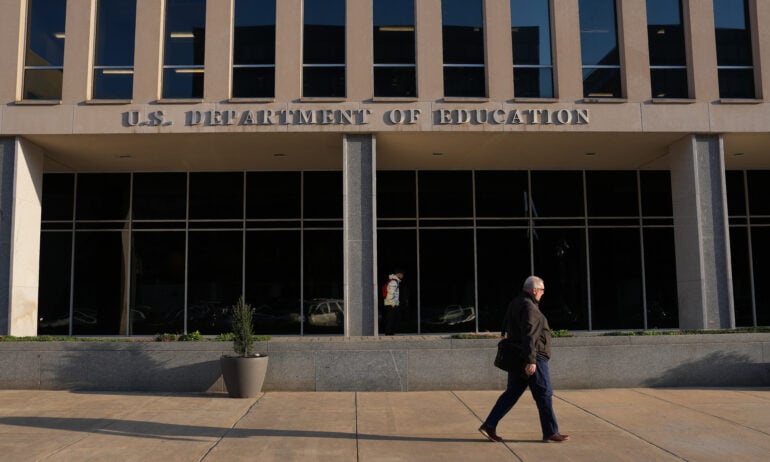Dismantling the U.S. Department of Education: What It Means for You
Here's a rundown of what is — and isn't — changing as the Trump administration breaks up the ED.

Many, or all, of the products featured on this page are from our advertising partners who compensate us when you take certain actions on our website or click to take an action on their website. However, this does not influence our evaluations. Our opinions are our own. Here is a list of our partners and here's how we make money.
Big changes are in store for the Education Department, with many of the agency's responsibilities shifting to other parts of the federal government. Here's an overview of what's happening, and what current and future students can expect.
What is happening to the Education Department?
An executive order made by the Trump administration on March 20 introduced the idea of eliminating the U.S. Department of Education (ED). The order, which proposed the closure of the ED, aimed to shift the department's responsibilities to state and local authorities. Earlier that month, the ED had already announced that nearly 50% of the department’s employees would be let go or placed on administrative leave as of March 21.
The significantly smaller department soldiered on through the spring and summer, even launching the 2026-2027 FAFSA early. Then, on Nov. 18, new partnerships with four federal agencies were announced. These partnerships allow the ED to reallocate some of its administrative work and regulatory tasks. Transferring these responsibilities would virtually eliminate the ED, though it would take Congressional action to actually close the department.
Here’s a breakdown of changes:
Department of Labor (DOL) to oversee elementary through high school and postsecondary education, including trade programs.
Department of Interior to work with Tribal governments and manage education programs and schools for Native Americans.
Department of Health and Human Services to facilitate accreditation of foreign medical schools and on-campus childcare for student parents.
Department of State to run federally-funded study abroad programs.
When do these changes take effect?
The announcement to dismantle portions of the ED and transfer them to other federal agencies was made in November. While the announcement did not cite a specific date for when these shifts will take place, it's likely that the wheels are already in motion. Changes could come as early as 2026.
What impact does this have on current students?
Numerous federal grant programs could be impacted by the dismantling of the ED. While the department states that grant programs shouldn't experience disruptions or changes to funding and eligibility criteria, we do know that these are among the grant programs are being transferred to the DOL:
Gaining Early Awareness and Readiness for Undergraduate Programs (GEAR UP), which provides college preparation support and scholarships for lower-income youth.
Augustus F. Hawkins Center of Excellence, which funds teacher training programs.
Title III programs, which offer grants to historically Black colleges and universities (HBCU).
Howard University, an HBCU that's partially federally funded.
Programs that offer grants funding college preparation and support for students with intellectual disabilities.
What impact does this have on future students?
The ED noted transferring grant programs to the DOL will strengthen the workforce.
Citing an annual labor shortage of 700,000, the ED claims that a partnership with the DOL will strengthen workforce development programs, improve career training and provide institutions with greater resources for innovation.
For future students, this may mean greater opportunities for funding for skilled careers.
However, other changes to educational policy based on the Trump administration's One Big, Beautiful Bill Act may not be so advantageous to student loan borrowers, particularly those pursuing postgraduate degrees. Beginning in July 2026, most graduate loans will be capped at $20,500 per year. Grad students pursuing professional degrees — as defined by ED — will be able to borrow up to $50,000 annually. Graduate programs for nurses, physician assistants and physical therapists are among those excluded from the current list of “professional” degrees outlined in the law.
What will happen to federal student loans?
ED's partnership announcement did not address what will happen to the department's nearly $1.7 trillion student loan portfolio, or processing or disbursement of federal student loans. Earlier this year, the president speculated about moving federal student loans to the Small Business Administration. The Treasury Department was also considered as a new home for federal loans. Most recently, there have been concerns about parts of the federal student loan portfolio being sold to private investors.
As of now though, federal student loans remain under ED. While many ED programs are being shifted to other agencies, the federal student loan system — from FAFSA to forgiveness — falls under the Office of Federal Student Aid (FSA). Since it was established by an act of Congress, it would likely take Congressional action to move the FSA to a different department. Critics have likewise pointed out numerous issues with privatizing part or all of the existing federal loan portfolio.
Long story short: There aren't immediate changes to federal student loans. It is important to be aware, however, that the OBBBA introduced numerous changes to loan repayment. For example, the new Repayment Assistance Plan is slated to replace current income driven repayment plans. Those changes start rolling out in July 2026.
Will FAFSA applications be affected?
No. Free Application for Federal Student Aid (FAFSA) forms are still being processed by the Department of Education, and you should submit your form if you haven't yet. The 2026-27 FAFSA application is available with a deadline of June 30, 2027.
» MORE: FAFSA checklist
However, don’t wait to finish your FAFSA. Submit it as early as possible to make sure you're eligible for as much available aid as possible. Colleges and universities set their own FAFSA deadlines, and priority aid deadlines can be even earlier. If you are a dependent student, you and your parents must both complete the FAFSA form in order for you to be considered for federal, state and institutional aid.






